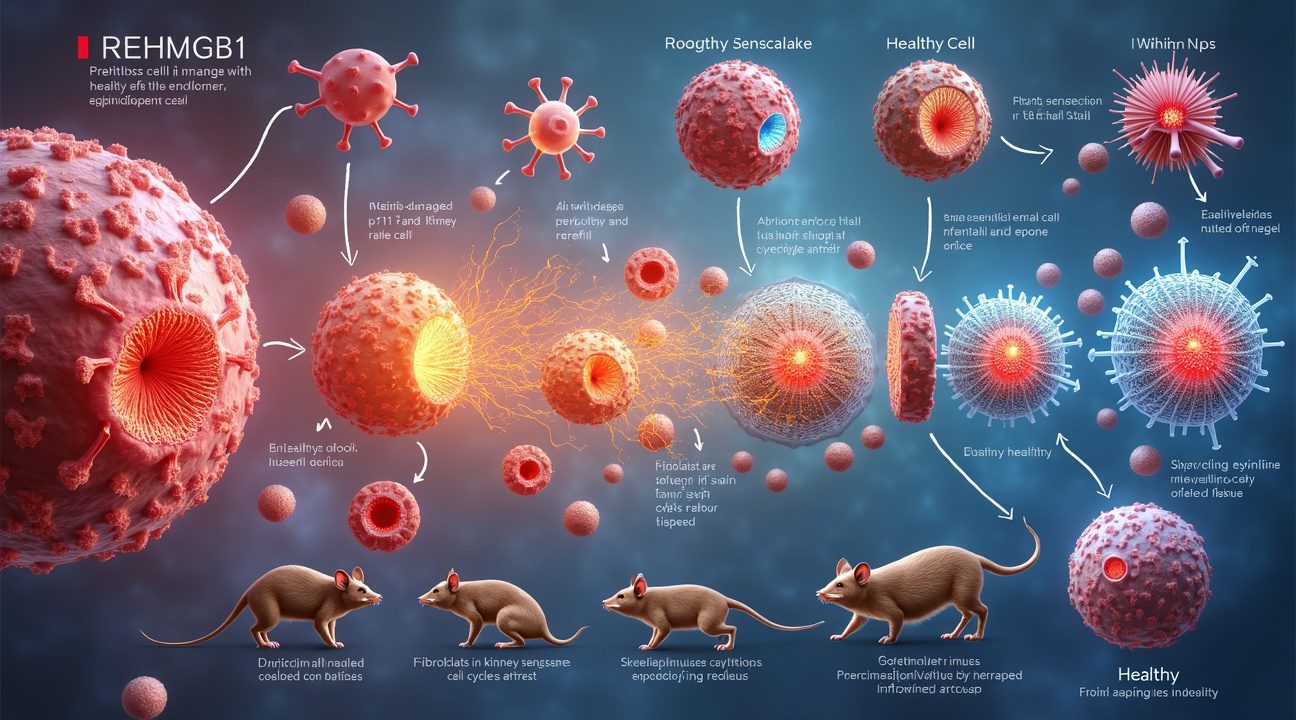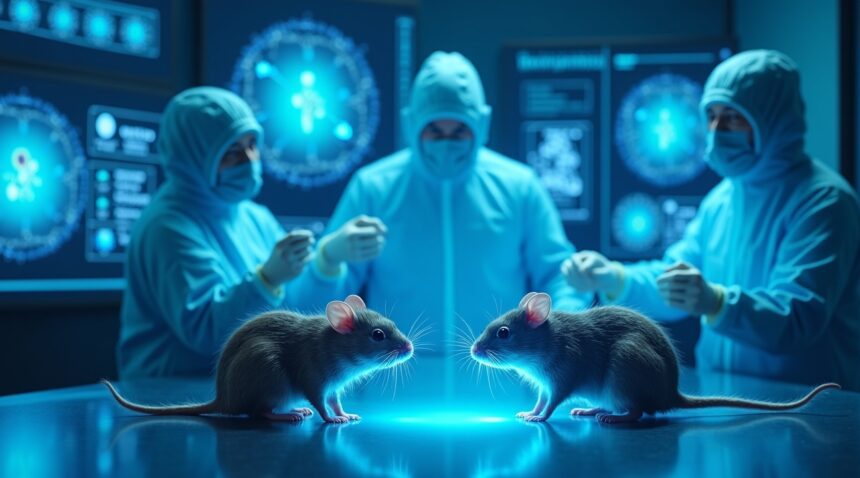Scientists have made a revolutionary breakthrough by identifying ReHMGB1 as a primary protein responsible for transmitting aging signals throughout the body.
Breakthrough Discovery in Aging Research
In a significant leap forward, researchers discovered that the protein ReHMGB1 acts as a central aging messenger. By transmitting senescence signals from older or damaged cells through the bloodstream, it accelerates aging in otherwise healthy tissues. This finding not only explains how aging spreads throughout the body but also offers a new pathway to halt or even reverse its effects.
Targeted Treatment Using Antibodies
Through laboratory studies using mice, scientists managed to block the ReHMGB1 protein with specific antibodies. This targeted approach did more than just slow down visible aging; it reversed key signs of cellular deterioration. Muscle regeneration rates improved, cellular aging markers declined, and physical performance increased significantly.
Key Takeaways
- ReHMGB1 acts as a master aging messenger that spreads senescence signals from damaged cells to healthy tissues throughout the body via the bloodstream.
- Targeted antibody treatment against ReHMGB1 dramatically reduced cellular aging markers, improved muscle regeneration, and enhanced physical performance in mice.
- The therapy addresses root causes rather than symptoms by blocking the protein that triggers the domino effect of aging across multiple organ systems.
- Systemic inflammation was significantly reduced across multiple organ systems, suggesting the treatment could address various age-related diseases simultaneously.
- Clinical applications could begin within the next decade, with the potential to prevent, halt, or reverse age-related decline in humans rather than just treating individual symptoms.
Looking Ahead
This research marks the first time a systemic aging signal has not only been identified but also successfully targeted. It redefines aging treatment from symptom management to potential rejuvenation therapy. Scientists are optimistic that future clinical applications in humans may be just years away, potentially reshaping aging and age-related disease care permanently.
Blocking a Single Protein Reverses Aging Damage in Mice
The breakthrough discovery that blocking ReHMGB1 can reverse aging damage represents a monumental shift in how scientists approach age-related decline. Researchers demonstrated that targeted antibodies against this protein can effectively halt and even reverse cellular senescence in laboratory mice, opening unprecedented possibilities for anti-aging interventions.
Successful Antibody Treatment Shows Dramatic Results
Scientists administered ReHMGB1 antibodies to both aged and injured mice, achieving remarkable outcomes that exceeded expectations. The treatment significantly reduced cellular senescence markers throughout the animals’ bodies, effectively turning back the biological clock at the cellular level. SASP marker expression dropped substantially, indicating that the inflammatory cascade driving aging had been interrupted. This senescence blockade didn’t just slow decline—it actively reversed damage that had already occurred.
The intervention’s effects extended far beyond cellular markers. Muscle regeneration improved dramatically in treated mice compared to control groups, with tissue repair mechanisms functioning at levels typically seen in much younger animals. Physical performance metrics showed substantial improvements, suggesting that the therapy’s benefits translate into real-world functional gains. These results demonstrate that targeting a single protein can trigger cascading positive effects throughout the body’s systems.
Systemic Inflammation Reduction and Clinical Implications
Perhaps most significantly, the ReHMGB1 antibody treatment reduced systemic inflammation across multiple organ systems. This whole-body anti-inflammatory effect represents a crucial breakthrough because chronic inflammation drives many age-related diseases and functional decline. The reduction in inflammatory markers suggests that this anti-aging therapy could potentially address multiple age-related conditions simultaneously rather than treating them individually.
The research marks the first time scientists have successfully identified and targeted a systemic aging signal, fundamentally changing how researchers think about aging interventions. Previous approaches focused on addressing individual symptoms or diseases associated with aging, but this discovery offers a more comprehensive strategy. By blocking ReHMGB1, researchers can potentially interfere with the fundamental mechanisms that drive aging across multiple tissue types and organ systems.
This tissue regeneration approach differs from traditional anti-aging strategies because it addresses root causes rather than symptoms. The protein’s role in spreading senescence signals means that blocking it can prevent the domino effect that typically accelerates aging throughout the body. Scientists observe that this represents a paradigm shift from managing age-related decline to actively reversing it.
The implications extend beyond laboratory settings. If similar results can be achieved in humans, this intervention could provide a potent strategy to slow, halt, or potentially reverse features of age-related decline. The therapy’s ability to improve physical performance while reducing inflammation suggests multiple potential applications across various age-related conditions.
Current research focuses on understanding the optimal timing and dosing for ReHMGB1 antibody treatments. Scientists are investigating whether early intervention can prevent age-related decline from occurring, while also exploring whether the therapy can reverse established aging damage in various organ systems. The protein’s central role in aging processes suggests that blocking it could have far-reaching benefits that researchers are only beginning to understand.
The successful targeting of ReHMGB1 also opens doors for developing additional interventions that work synergistically with this approach. Researchers are exploring combination therapies that might enhance the antibody treatment’s effectiveness or extend its duration of action. This discovery provides a foundation for developing comprehensive anti-aging strategies that could transform how society approaches aging and age-related health challenges.

Scientists Pinpoint ReHMGB1 as the Master Aging Signal
I’ve discovered that aging doesn’t just happen in isolation within individual cells or tissues. Scientists have now identified a specific protein that acts as a messenger, spreading aging signals throughout the entire body like a biological alarm system. This protein, known as the reduced form of High Mobility Group Box 1 (ReHMGB1), represents a breakthrough in understanding how aging spreads systematically.
The Redox-Sensitive Nature of HMGB1
ReHMGB1 operates as a redox-sensitive protein, meaning its function depends entirely on its chemical state. Only the reduced form can transmit senescence signals effectively, while the oxidized form remains inactive in this process. This distinction proves crucial because it explains why some aging signals spread while others don’t. The protein’s sensitivity to oxidation and reduction creates a biological switch that determines whether aging signals propagate throughout the body.
Senescent cells—those that have stopped dividing due to stress, aging, or damage—release ReHMGB1 into circulation. These cellular zombies don’t just sit quietly; they actively communicate their damaged state to distant tissues. Once ReHMGB1 enters the bloodstream, it travels to remote locations where it can induce healthy cells to become senescent as well.
Systemic Amplification of Aging Effects
The amplification process creates a domino effect that accelerates aging across multiple organ systems. When ReHMGB1 reaches healthy tissues, it doesn’t simply cause minor damage—it converts functioning cells into senescent ones, expanding the population of aging cells exponentially. This systemic spread helps explain why aging often appears to accelerate over time rather than progressing at a steady pace.
Scientists have observed that blocking ReHMGB1 activity can reverse some of this damage, suggesting that targeting this protein could offer new therapeutic approaches. The discovery connects to broader research on cellular aging mechanisms, similar to how genetic research reveals biological processes that were previously mysterious.
This finding fundamentally changes how researchers view aging as a biological process. Rather than seeing it as isolated cellular deterioration, they now understand aging as a coordinated, communicable condition where damaged cells actively recruit healthy ones to join their senescent state through ReHMGB1 signaling.
How This Protein Transforms Healthy Cells Into Aged Ones
Once ReHMGB1 exits cells, it becomes a powerful aging messenger that fundamentally alters how healthy cells function. The protein targets specific receptors on cell surfaces, triggering a cascade of molecular events that essentially force these cells to age prematurely. This binding process activates critical pathways that lead healthy, dividing cells to halt their normal growth cycle through a mechanism called cell cycle arrest.
The Molecular Switch That Triggers Aging
When ReHMGB1 successfully binds to cellular receptors, it flips a molecular switch that transforms the cell’s behavior completely. Affected cells begin producing two key proteins – p21 and p16 – which scientists recognize as definitive markers of cellular senescence. These proteins act like cellular brakes, preventing cells from continuing their normal division process and pushing them into an aged state.
The transformation doesn’t stop there. These newly aged cells undergo a complete personality change, shifting from productive tissue contributors to inflammatory troublemakers. They start releasing a cocktail of harmful molecules known as the senescence-associated secretory phenotype, or SASP. This toxic mix includes pro-inflammatory compounds and tissue-degrading enzymes that damage surrounding healthy tissue and spread aging signals to neighboring cells.
Widespread Impact Across Different Cell Types
Research has revealed that ReHMGB1’s aging effects aren’t limited to just one type of cell. Scientists have observed these damaging transformations across multiple cell varieties, demonstrating the protein’s broad destructive potential. The following cell types showed significant aging responses when exposed to ReHMGB1:
- Human fibroblasts, which are crucial for maintaining skin structure and wound healing
- Kidney epithelial cells that perform essential filtering functions
- Skeletal muscle cells responsible for movement and strength
This widespread susceptibility suggests that ReHMGB1 can accelerate aging processes throughout the body, affecting multiple organ systems simultaneously. The protein’s ability to target such diverse cell types explains why aging often manifests as a systemic process rather than being confined to specific tissues.
Studies in mice have provided compelling evidence of ReHMGB1’s system-wide effects. When researchers administered the protein systemically to laboratory mice, they observed increased cellular aging markers throughout the animals’ bodies. More concerning, these molecular changes translated into measurable impairments in tissue function, suggesting that ReHMGB1 doesn’t just create aged-looking cells but actually compromises their ability to perform essential biological tasks.
The research findings illuminate why blocking this protein shows such promise for anti-aging interventions. By understanding exactly how ReHMGB1 transforms healthy cells into aged ones, scientists can develop targeted strategies to interrupt this process. The protein’s role as a systemic aging signal explains how damage in one area of the body can accelerate aging throughout the entire organism.
What makes these discoveries particularly significant is how they connect cellular aging with functional decline. The transition from healthy, dividing cells to senescent ones isn’t merely cosmetic – it represents a fundamental shift in how tissues maintain themselves and respond to stress. When cells stop dividing and start secreting inflammatory molecules, they contribute to the tissue dysfunction and increased disease susceptibility that characterize aging.
This mechanistic understanding opens new possibilities for therapeutic intervention. Rather than trying to treat aging as an inevitable decline, researchers can now target the specific molecular pathways that ReHMGB1 activates. By preventing this protein from binding to cellular receptors or blocking the downstream pathways it triggers, scientists might be able to maintain cellular youth and preserve tissue function even as organisms age chronologically.

The Science Behind Aging’s Spread Through Blood
Cellular senescence creates a cascade of harmful effects that extend far beyond individual damaged cells. I’ve observed how scientists have uncovered the mechanisms through which aging signals travel throughout the body, fundamentally changing our understanding of how we age.
The Senescence-Associated Secretory Phenotype
The senescence-associated secretory phenotype (SASP) represents a comprehensive collection of molecules that senescent cells release into their surroundings. These cells, which have stopped dividing but remain metabolically active, secrete a potent mixture of cytokines, chemokines, and proteases that promote inflammation and tissue dysfunction across multiple organ systems.
SASP components don’t remain localized to their origin points. Instead, they create a domino effect that spreads damage throughout the body. The inflammatory molecules trigger neighboring healthy cells to enter senescence, while proteases break down essential structural proteins in tissues. This creates a self-perpetuating cycle where aging accelerates in previously healthy areas.
Exosomes as Aging Messengers
Recent research has illuminated another critical pathway through which aging signals spread: exosomes. These tiny vesicles, released by senescent cells, function as sophisticated delivery systems that transport aging-related proteins, lipids, and microRNAs directly to distant tissues.
Exosomes represent particularly efficient carriers because they can:
- Cross biological barriers that larger molecules cannot penetrate
- Target specific cell types through surface proteins
- Deliver multiple types of aging signals simultaneously
- Travel through the bloodstream to reach organs throughout the body
- Resist degradation during transport
Scientists have identified exosomes as potential biomarkers for age-related conditions, offering new possibilities for early detection and monitoring of aging processes. The content of these vesicles changes predictably as we age, providing measurable indicators of biological aging that may prove more accurate than chronological age alone.
While both SASP components and exosomes contribute significantly to local and systemic aging, the recent identification of ReHMGB1 as a redox-sensitive, bloodborne messenger represents a breakthrough in aging research. This protein operates differently from traditional aging signals because researchers can potentially block its activity, offering the first real prospect of interrupting the aging cascade.
ReHMGB1’s unique properties make it an ideal target for intervention. Unlike the complex mixture of SASP molecules or the diverse cargo of exosomes, this single protein serves as a master regulator of aging signals throughout the circulatory system. When scientists blocked ReHMGB1 in laboratory studies, they successfully reversed aging-related damage, suggesting that targeting this protein could slow or even reverse aspects of the aging process.
The discovery connects directly to broader research on aging mechanisms, much like how genetic preservation techniques have revealed new possibilities in biological science. The ability to identify and target specific aging signals represents a fundamental shift from treating age-related diseases after they occur to preventing the underlying processes that cause them.
This research opens new avenues for therapeutic development. Rather than addressing individual age-related conditions separately, scientists can now consider interventions that target the root mechanisms of aging itself. The blood-based nature of these signals means that treatments could potentially be delivered systemically, affecting multiple organs and tissues simultaneously.
Understanding how aging signals spread through blood also explains why age-related diseases often cluster together in older adults. The same circulating factors that promote cellular senescence in one organ system simultaneously affect others, creating the multiple health challenges commonly seen in aging populations. By interrupting these signals at their source, researchers may be able to prevent or delay the onset of multiple age-related conditions simultaneously.
What This Breakthrough Means for Anti-Aging Medicine
I believe this discovery marks a pivotal moment in longevity research, transforming how scientists view aging from an isolated cellular event to a communicable biological process. ReHMGB1’s role as an aging messenger fundamentally changes our understanding of why damage spreads throughout the body rather than remaining confined to specific tissues.
Therapeutic Applications on the Horizon
Pharmaceutical companies can now develop targeted interventions that block ReHMGB1’s harmful aging signals while preserving its beneficial functions. These potential treatments include:
- Monoclonal antibodies designed to neutralize ReHMGB1 in circulation
- Small molecule inhibitors that prevent ReHMGB1 release from damaged cells
- Receptor blockers that stop healthy cells from receiving aging signals
- Combination therapies that enhance cellular repair mechanisms
The challenge lies in creating precise interventions that don’t interfere with ReHMGB1’s essential role in wound healing and immune responses. I recognize that this protein serves as a critical alarm system, alerting tissues to injury and coordinating repair processes. Future drugs must distinguish between ReHMGB1’s protective functions and its age-promoting effects.
Clinical applications could revolutionize treatment approaches for age-related diseases. Rather than addressing symptoms after they appear, doctors might prevent systemic aging by intercepting the molecular signals that spread damage between tissues. This shift from reactive to preventive medicine represents a fundamental change in healthcare strategy.
Regenerative medicine stands to benefit significantly from these insights. Understanding how aging signals interfere with tissue repair helps explain why older adults heal more slowly and why stem cell therapies sometimes fail in elderly patients. Just as AI research has transformed technology, this protein research could transform medicine by enabling treatments that restore youthful regenerative capacity.
I foresee clinical trials beginning within the next decade, focusing initially on age-related conditions where localized damage causes widespread deterioration. Cardiovascular disease, neurodegenerative disorders, and musculoskeletal conditions represent prime targets for ReHMGB1-based interventions.
The systemic nature of this discovery means that blocking aging signals could potentially slow multiple age-related processes simultaneously. Instead of treating each condition separately, a single intervention might address the underlying communication network that connects aging across different organ systems. This holistic approach could extend healthspan while reducing the complexity and cost of age-related medical care.
Success in this field requires careful balance between innovation and safety, ensuring that blocking harmful aging signals doesn’t compromise the body’s natural defense and repair mechanisms.

The Broader Impact on Longevity Research
This discovery represents a monumental shift in how researchers approach aging at the cellular level. For decades, scientists treated aging as an inevitable biological clock ticking down in isolated cells throughout the body. The identification of ReHMGB1 as a key messenger protein changes everything by revealing aging’s infectious nature — it actually spreads from cell to cell like a biological contagion.
A New Framework for Understanding Aging Transmission
I find it fascinating that aging can now be understood through the lens of infectious disease models. When damaged cells release ReHMGB1, they essentially broadcast distress signals that neighboring healthy cells interpret as instructions to begin their own aging process. This creates a cascading effect where cellular damage accelerates exponentially throughout tissues and organs.
The research demonstrates that blocking ReHMGB1’s aging signals doesn’t interfere with its beneficial functions during injury response. This dual nature makes it an ideal therapeutic target because treatments can preserve the protein’s helpful roles while eliminating its harmful aging-promotion activities. Scientists can now design interventions that specifically target the aging pathway without compromising the body’s natural healing mechanisms.
Implications for Future Therapeutic Development
The success observed in mouse models opens several promising avenues for human applications. Researchers can now focus their efforts on developing drugs that either block ReHMGB1 receptors or neutralize the protein’s aging-promoting signals. This targeted approach differs significantly from previous anti-aging strategies that often involved broad interventions with unpredictable side effects.
Clinical translation appears increasingly feasible given the clear mechanism of action and positive results in animal studies. The research team’s ability to reverse existing aging damage in mice suggests that future treatments might not only prevent further aging but actually restore youthful cellular function. This possibility has profound implications for treating age-related diseases like:
- Alzheimer’s
- Cardiovascular disease
- Cancer
Human trials targeting this pathway could realistically begin within the next several years, according to the research timeline. The clear molecular target and established safety profile in animal models provide a strong foundation for regulatory approval processes. Unlike previous longevity research that struggled with vague mechanisms and unclear endpoints, this discovery offers specific, measurable targets that regulatory agencies can evaluate effectively.
The broader scientific community now has a concrete framework for investigating aging’s systemic nature. Research groups can explore how different tissues respond to ReHMGB1 signals and identify additional molecular players in the aging cascade. This understanding could lead to combination therapies that target multiple points in the aging pathway simultaneously.
Perhaps most significantly, this discovery validates the concept that aging itself can be treated as a disease rather than an inevitable biological process. By demonstrating that aging signals can be interrupted and reversed, the research fundamentally challenges traditional assumptions about human lifespan limitations. Future scientific breakthroughs in related fields may build upon this foundation to develop comprehensive anti-aging interventions.
The pharmaceutical industry is already taking notice of these findings, with several companies reportedly investigating ReHMGB1-targeting compounds. The clear commercial potential of effective anti-aging treatments provides strong incentives for rapid development and testing of therapeutic candidates.
This research also highlights the importance of understanding protein functions in different biological contexts. ReHMGB1’s beneficial role in injury response demonstrates that effective therapies must be precisely targeted rather than broadly suppressive. Future drug development will need to account for these context-dependent protein functions to avoid unintended consequences.
The discovery establishes aging research as a legitimate medical discipline with clear therapeutic targets and measurable outcomes. This legitimacy attracts increased funding and talent to the field, accelerating the pace of discovery and development. Researchers can now approach aging with the same systematic methodology used to combat infectious diseases or cancer.
Sources:
Technology Networks: “Researchers Uncover Mechanism of Aging Spread Through the Bloodstream”
Study Finds: “Aging Spreads Through The Body Like An Infection, And This …”
Aging-US News Room: “New Study Links Exosomes to Biological Aging”
Neuroscience News: “Aging Spreads Through the Bloodstream”
ScienceAlert: “Aging Can Spread Through Your Body Via a Single Protein, Study Finds”
EurekAlert: “This blood protein could be spreading aging throughout your body”


